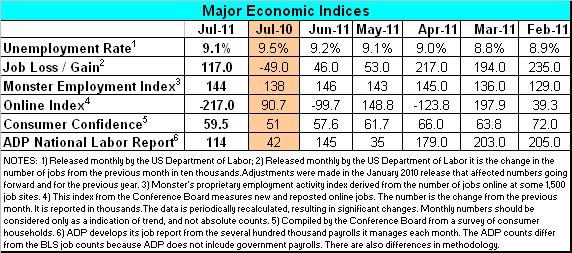With Wall Street braced for the worst, the U.S. Labor Department had good news this morning. The U.S. economy added 117,000 jobs in July and the unemployment rate dipped to 9.1 percent.
Coming the day after the Dow plunged more than 500 points, the better-than-expected jobs numbers offered some relief from the last two weeks of pessimistic reports about the economy. Stocks opened higher.
Estimates ahead of the report pegged job growth at around 90,000 during July, though some economists said the number could be as low as 55,000. The unemployment rate, which ticked up in June to 9.2 percent, was expected to be unchanged. ADP’s National Employment Report Wednesday, which is not often in sync with the government report, said 114,000 private sector jobs were added in July. The BLS put that number at a 154,000. Government job losses offset the private sector gains.
The U.S. Bureau of Labor Statistics, which compiles and maintains labor data for the U.S., also revised upwards jobs numbers for May by 53,000 and June by 46,000.

Several sectors added jobs in July. Manufacturing, which an Institute for Supply Management report suggested may have showed in July, added 24,000 jobs, twice June’s number. Construction, one of the hardest hits sectors in the recession, added 8,000 jobs.
The biggest increases came in healthcare (up 31,300 jobs) and in professional and business services, which added 34,000 jobs. The big gains there were in administrative and support services. Retail added 25,900 jobs.
Despite the decline in the unemployment rate — small enough statistically that the BLS referred to the rate as “little changed” — the overall number of unemployed and the underemployed remains high. In July, 13.9 million Americans were out of work. Of that, 6.2 million have been unemployed for more than six months.
Another 8.4 million are working part-time because they can’t find full-time jobs. Add to that the 2.8 million who are “marginally attached,” a category meaning people who want work, but didn’t look for it during the July survey period.
Wages increased by 0.4 percent hourly to an average of $23.13. And the average workweek remained at 34.3 hours. The average manufacturing work week stayed at 40.3 hours and factory overtime didn’t increase from June’s 3.1 hours.
Canada, which also released employment data for July, said the nation’s unemployment rate fell to 7.2 percent, the lowest rate since 2008. Some 7,100 jobs were added during the month, with the gains coming in many of the same sectors as in the U.S. Economists had expected a more robust 15,000 jobs.
With a population of 34 million, the pace of job growth is quicker than in its bigger, southern neighbor. However, Statistics Canada said wage growth was the slowest in eight years.
For more than an hour this morning, the Bureau’s website — and therefore its report — was unavailable. The usual practice is for the Bureau to post the report online at 8:30 a.m. in Washington, prior to the opening of U.S. financial markets. A select group of business writers assembles in the Bureau’s offices prior to the release time getting advance copies from which accounts are written.
What happened to cause the BLS website to become inaccessible isn’t known.
